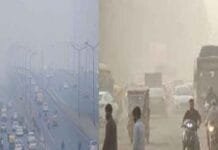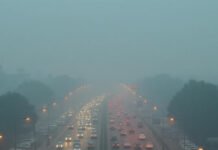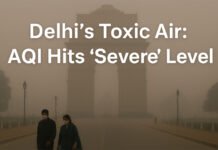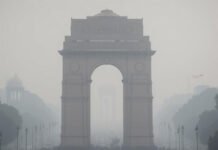New Delhi, 2 November 2025 —
As the chill of early winter sets in, Delhi once again finds itself under a grey, choking sky. The Air Quality Index (AQI) crossed 303 on Sunday, placing the capital firmly in the “very poor” category. Environmental officials have warned that the coming two weeks could become “the most polluted fortnight of the year.”
The System of Air Quality and Weather Forecasting and Research (SAFAR) attributed the rapid decline to north-westerly winds carrying farm-fire smoke from Punjab and Haryana, combined with falling night-time temperatures that trap pollutants near the ground.
A Familiar Seasonal Crisis
For residents, November’s toxic air has become an annual ordeal. “It’s like breathing poison every morning,” said Meena Verma, a teacher in south Delhi, adding that her children wake up coughing despite indoor air purifiers running round the clock.
Hospitals reported a 20% increase in respiratory and cardiac emergency cases since late October. Dr Rajeev Gupta of AIIMS told The Hindu:
“We see a surge in asthma, COPD and bronchitis cases every year around this time. The fine particulate matter (PM2.5) enters deep into the lungs and can trigger long-term heart and neurological diseases.”
Farm Fires: The Persistent Culprit
Satellite imagery from the Indian Space Research Organisation (ISRO) showed nearly 2,100 active farm-fire spots across Punjab and Haryana in the past 48 hours. Despite repeated interventions, the burning of paddy stubble continues unabated.
Punjab Pollution Control Board officials admitted enforcement remains difficult. “We are working with local farmers, but alternatives like bio-decomposers and happy seeders are still expensive,” one senior officer said.
The Commission for Air Quality Management (CAQM) has urged neighbouring states to curb fires and directed Delhi to intensify anti-pollution measures under GRAP Stage IV — the most severe action level.
Government Measures
The Delhi Government re-implemented an odd-even vehicle scheme, banned construction activity, and closed all primary schools until further notice.
Environment Minister Gopal Rai stated:
“We are taking every possible step, but cooperation from neighbouring states is essential. This is not just Delhi’s problem; it’s a regional emergency.”
The Centre’s Graded Response Action Plan (GRAP) also called for increased mechanical road sweeping, dust suppression, and curbs on diesel-generator use.
Meanwhile, the Supreme Court is set to hear a public-interest petition this week on stricter enforcement of stubble-burning bans and state accountability.
Experts Urge Long-Term Solutions
Environmentalists argue that temporary bans cannot resolve a systemic issue. Sunita Narain, Director-General of the Centre for Science and Environment (CSE), commented:
“We treat pollution as a seasonal inconvenience instead of a public-health emergency. The solution lies in investing in clean energy, urban transport, and crop-residue management all year round.”
According to a 2024 World Bank report, Delhi loses nearly ₹ 57,000 crore annually to pollution-related health costs and productivity losses.
Citizens Turn to Technology
With AQI monitors now common in households, Delhiites have adopted new coping mechanisms. Demand for air purifiers and N95 masks has surged, while ride-share companies report fewer outdoor trips.
Social-media groups like Clean Air Collective and War on Smog are urging residents to use public transport, carpooling, and indoor plants such as areca palm and snake plant to reduce indoor toxicity.
A Regional and National Concern
Neighbouring cities — Gurugram, Noida, and Ghaziabad — have also reported AQI readings between 290 and 310, confirming that the pollution blanket extends across the National Capital Region.
Meteorologists predict light rain mid-week that may provide temporary relief, but warn that pollution levels will likely rebound quickly.
Environmental lawyer Ritwick Dutta summed it up:
“Year after year, committees are formed and meetings held, but without strict accountability and farmer compensation reforms, Delhi’s smog will remain an annual tragedy.”
Conclusion
As India’s capital faces yet another smog season, the call for coordinated action grows louder. Delhi’s air crisis is more than an environmental issue — it is a test of governance, policy consistency, and regional cooperation. Unless the political will aligns with scientific urgency, the city’s skyline will remain a haze of unfulfilled promises.














